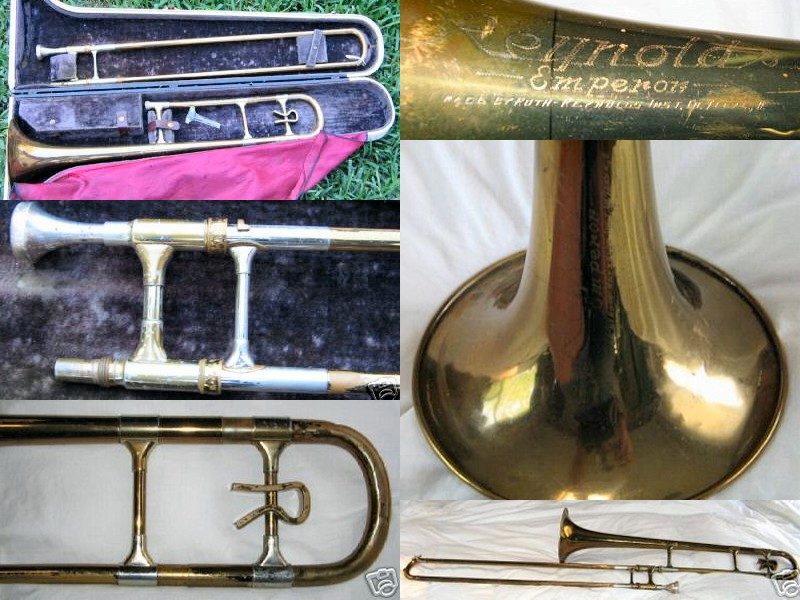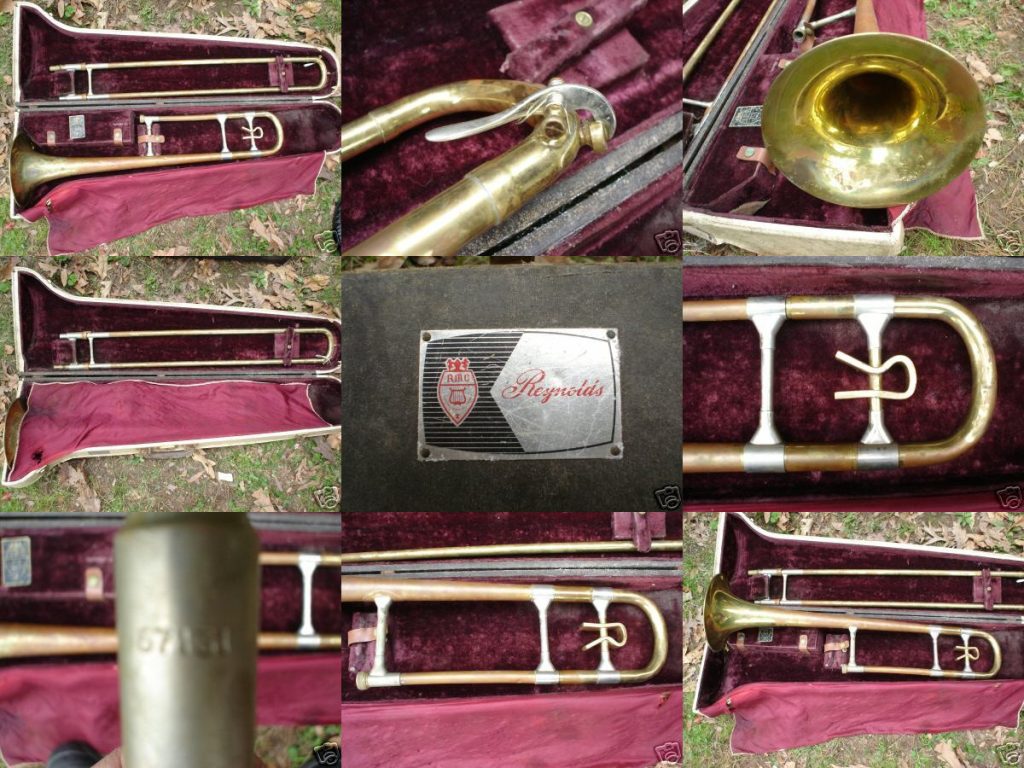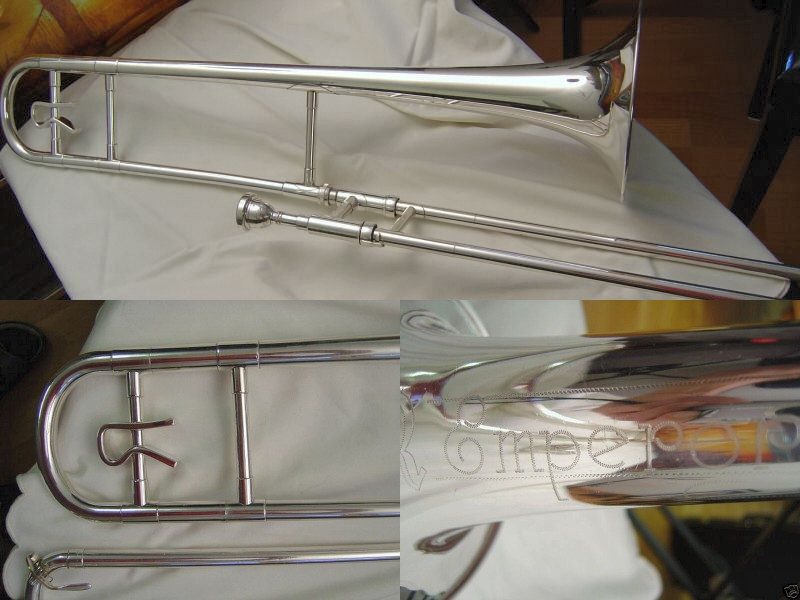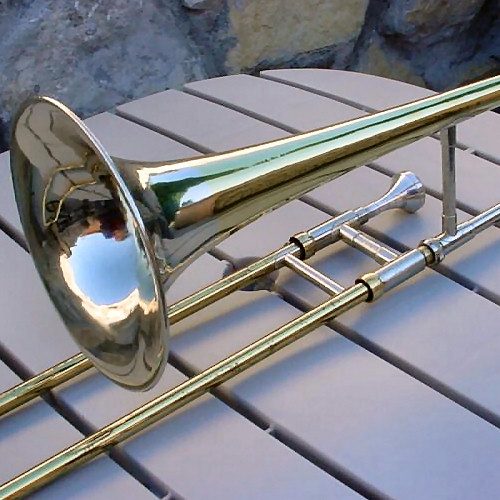
Introduced shortly after Scherl & Roth took over Reynolds in 1946, the Emperor trombone was targeted at advanced student musicians and community band players and positioned as a step up from the basic Roth model. Trademark documentation puts the Emperor name in first use in late 1947. However, the earliest known serial numbers are from around the same time that design changes were made to the Reynolds trombones and the Contempora model was introduced, ~1949.
The model name "Emperor" may have been chosen to counter an attempt by London-based Boosey & Hawkes to enter the U.S. market after World War II with their own Emperor model instruments, and to protect Scherl & Roth's international import and distribution connections.
1946-1952
F.A. Reynolds, division of Scherl & Roth (Cleveland, Ohio)
The characteristic nickel-silver bell flare was originally produced as part of the Roth instrument line. When the Emperor model launched, the catalog used the same "Tone Tempered" description as was previously used with the Roth model. Emperor models from this time period are stamped "Made by F.A. Reynolds".
Model 15
Reynolds Emperor Tenor Trombone
Bore: .500"
Bell: 7½", brass with nickel-silver bell flare
Materials: brass gooseneck and tuning slide; nickel silver bracing and trim
Slide: chrome-plated nickel silver inner slides; brass outer slides; nickel-silver hand grip and receiver
Finish: clear lacquer finish; optional silverplate bright bell or silverplate gold bell finish
Model 15B
Reynolds Emperor Tenor Trombone
Bore: .500"
Bell: 7½", brass
Materials: brass gooseneck and tuning slide; nickel silver bracing and trim
Slide: chrome-plated nickel silver inner slides; brass outer slides; nickel-silver hand grip and receiver
Finish: clear lacquer finish; optional silverplate bright bell or silverplate gold bell finish
These new "Tone Tempered" instruments are newly designed with a nickel silver bell flare, fused to brass bell tubing. They are all Tone Tempered to give a clear, crisp, sparkling tone. All are quality instruments, moderately priced.
Few trombones today have the flexibility, tone quality and well-balanced scale of this Tone Tempered creation. Has fast finely proportioned slides. Finished in brass and nickel slides--lacquered.
The Reynolds Emperor B♭ Bass Trombone is built in medium-large bore with rotary change to F and E♭ slide. An instrument that fills a long felt need for a bass trombone, not quite as large as the symphony model yet able to produce a big round, robust tone. The bell diameter is 8½ inches.
Model 17
Reynolds Emperor Trombone with F Attachment
Bore: .520"
Bell: 8½"
Body: brass bell with nickel-silver braces
Valve: rotary valve with F attachment and closed-wrap tubing; tuning slide to E♭
Slide: brass outer slide with brass sleeves and trim, nickel silver braces with brass ferrules; chrome-plated nickel silver inner slides
Finish: polished brass with clear lacquer
Model Note
The Emperor Model 17 was the first larger-bore tenor trombone with a rotary valve and F attachment in the Reynolds catalog. The "medium-large bore" description is the same that was used for the new Contempora tenor trombone at a documented .520" bore size.
The .520" trombone, with an 8½" bell, was the template for Professional (c.1953-54), Roth (c.1958), Contempora (c.1958), and Medalist Bass (1961) models.
With the exception of the latter, Reynolds stopped calling this configuration a "bass trombone" in 1959, instead relabeling all models as "tenor trombones with F attachment".
1952-1961
Roth-Reynolds (Cleveland, Ohio)
Originally marketed as a "Tone Tempered Bell", the nickel-silver bell was described as a deluxe "Silver Flare" bell in 1953. A standard brass bell model was also offered, with nickel silver trim being the main visible difference from the now-plain Roth model.
Reynolds Emperor Trombones designed for flexibility, fine tone quality and beautifully balanced scale. Nickel silver slides with chrome plated finish are correctly proportioned for fast action and durability. One-piece slides with drawn stockings. Deluxe models are equipped with "Silver-Flare" bells and both models are trimmed in nickel silver for rich appearance.
Model 15
Reynolds Emperor Tenor Trombone
Bore: .500"
Bell: 7½", brass with nickel-silver bell flare
Materials: brass gooseneck and tuning slide; nickel silver bracing and trim
Slide: chrome-plated nickel silver inner slides; brass outer slides; nickel-silver hand grip and receiver
Finish: clear lacquer finish; optional silverplate bright bell or silverplate gold bell finish
Model 15B
Reynolds Emperor Tenor Trombone
Bore: .500"
Bell: 7½", brass
Materials: brass gooseneck and tuning slide; nickel silver bracing and trim
Slide: chrome-plated nickel silver inner slides; brass outer slides; nickel-silver hand grip and receiver
Finish: clear lacquer finish; optional silverplate bright bell or silverplate gold bell finish
1961-1964
RMC/Reynolds (Cleveland, Ohio)
Sometime after Richards Music purchased Reynolds in 1961, the product catalog was renumbered. The old numbers were replaced with a new scheme that reflected the type of instrument. To the best of knowledge, the instrument specifications did not change, just the model numbers.
Model TO-52
Reynolds Emperor Tenor Trombone
Bore: .500"
Bell: 7½", brass
Materials: brass gooseneck and tuning slide; nickel silver bracing and trim
Slide: chrome-plated nickel silver inner slides; brass outer slides; nickel-silver hand grip and receiver
Finish: clear lacquer finish; optional silverplate bright bell or silverplate gold bell finish
Serious students and professionals will find this a modest-priced trombone particularly well-designed for flexibility, rich tone quality and beautifully balanced scale. One-piece slides with drawn stockings are hard chrome-plated nickel silver. Solid brass 7½ inch bell. Medium bore.
Historical Note
In conjunction with the premiere of Warner Bros.’ motion picture, Meredith Willson’s “The Music Man” (1962), RMC/Reynolds sponsored “The Music Man Contest” for individual musicians between ages 8-18, with national, regional and local award winners. “Official Music Man” models of the brass-bell Emperor trumpet, cornet and trombone were produced in conjunction with the contest.
1964-1970
Reynolds (Fullerton, Calif.; Abilene, Texas)
After CMI purchased the assets to Reynolds, trumpets, cornets, trombones and French horns were made at the Olds factory in Fullerton, Calif. There were slight adjustments to the model specifications compared to the Cleveland instruments. One of the results of this move is that Olds’ traditional dual-bore trombone design was implemented on many of Reynolds’ student horns, including the Medalist and Emperor models. Note also the change in bell bracing ferrules.
Modestly priced for serious students who profit by its flexibility, rich tone quality and beautifully balanced scale. Medium bore; 7½" bell; solid nickel-silver slide receiver, tuning slide and bell flare. Professional mouthpiece, music lyre, modern case included.
Model TO-52
Reynolds Emperor Tenor Trombone
Bore: .485"/.500" dual bore
Bell: 7½", brass with nickel-silver bell flare
Materials: nickel silver tuning slide, gooseneck, bracing and trim
Slide: chrome-plated nickel-silver inner slides; brass outer slides with nickel-silver slide receiver
Finish: baked epoxy coating; optional silverplate bright bell or silverplate gold bell finish
Other: Brass “R” counterweight
Solid nickel-silver receiver, tuning slide and bell flare give this instrument a distinctive tonal quality. Lightweight as an aid to the young player. Dual bores of .485 and .500 so that the performer can obtain a full tone with less effort. Bell flare measures 7½".
1970-1979
Reynolds (Fullerton, Calif.)
In 1970, Reynolds fully merged production lines with Olds in Fullerton. In most cases, a horn would come off the California production line and become either a Reynolds- or Olds-branded instrument based on detailing and finish. The traditional Emperor TO-52 was produced until sometime between 1970 and 1973, then the nickel-plated TO-50 was introduced. The latter appears to be the same as the Olds Special, Model NL-15.
Model TO-52
Reynolds Emperor Tenor Trombone
Bore: .485"/.500" dual bore
Bell: 7½", brass with nickel-silver bell flare
Materials: nickel silver tuning slide, gooseneck, bracing and trim
Slide: chrome-plated nickel-silver inner slides; brass outer slides with nickel-silver slide receiver
Finish: baked epoxy coating; optional silverplate bright bell or silverplate gold bell finish
Other: Brass “R” counterweight
The Emperor Trombone has been designed for the young player who has progressed beyond the beginning stages. Withstands hard use and has a beautiful, rich, full sound. Nickel-plated for contemporary appearance and sound. Lightweight and precision balanced. Dual bore permits a full tone with less effort. Complete with instrument luggage and accessories.
Model TO-50
Reynolds Emperor Tenor Trombone
Bore: .485"/.500" dual bore
Bell: 7½", brass with nickel-silver bell flare
Materials: nickel silver tuning slide, gooseneck, bracing and trim
Slide: chrome-plated nickel-silver inner slides; brass outer slides
Finish: baked epoxy coating
Other: rectangular “Reynolds” counterweight
The purpose of this website is to preserve the history of the F. A. Reynolds Company and the distinctive qualities of its brass instruments. Contempora Corner and contemporacorner.com are not related or associated in any way to the former or current F.A. Reynolds Company.
Copyright © 2004-2024 ElShaddai Edwards. All Rights Reserved. Terms of Use.

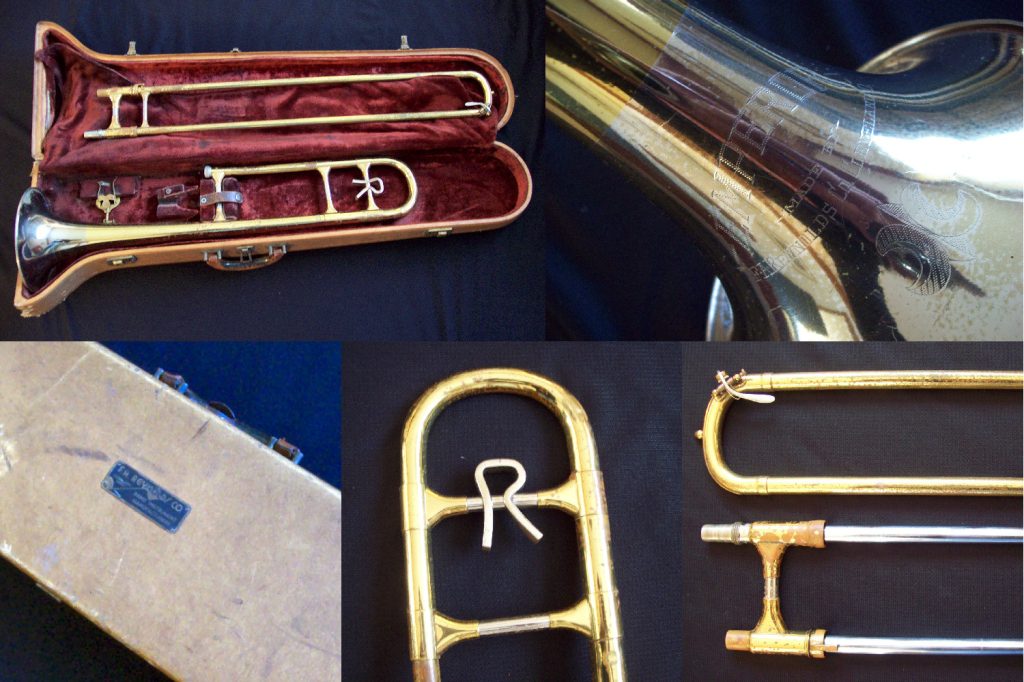
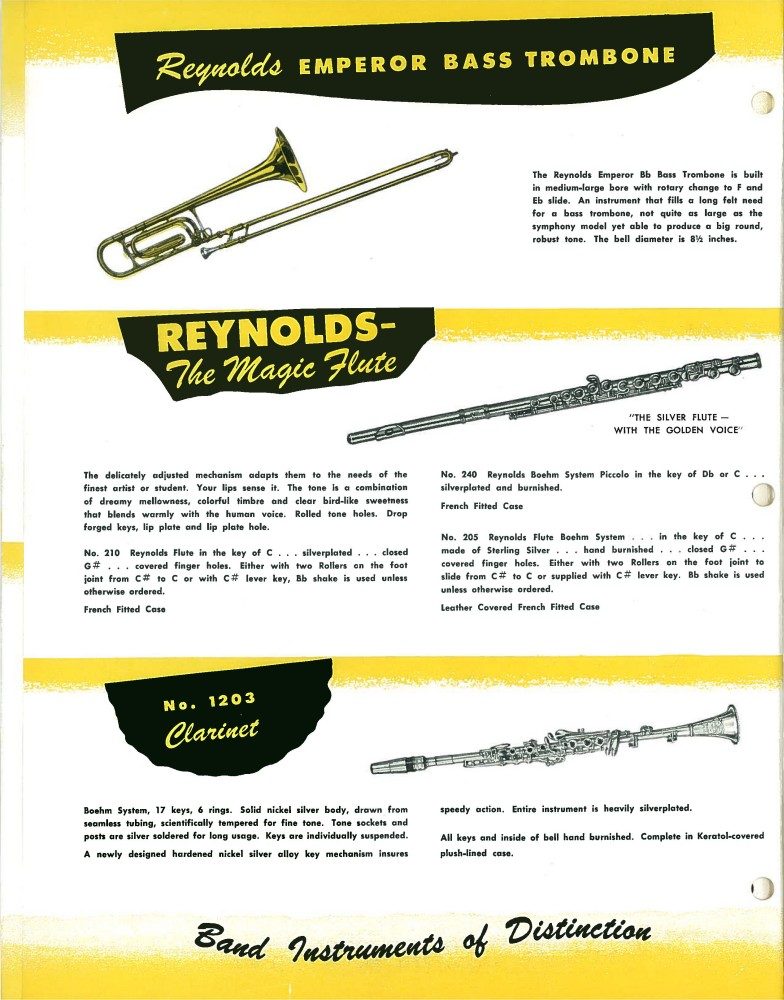
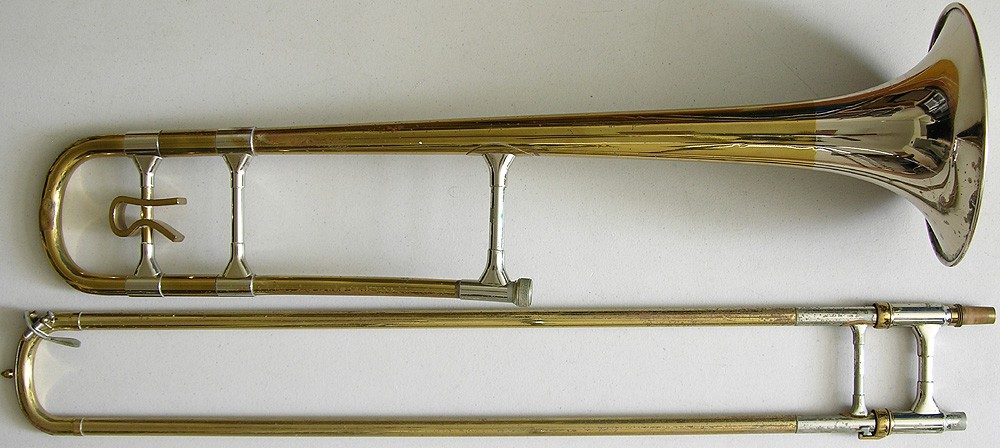
![Model TBD [SN 61123]. Photos used with permission from Lauderdale Wind (eBay Member: algee2).](https://contemporacorner.com/wp-content/uploads/2009/01/0611231.jpg)
